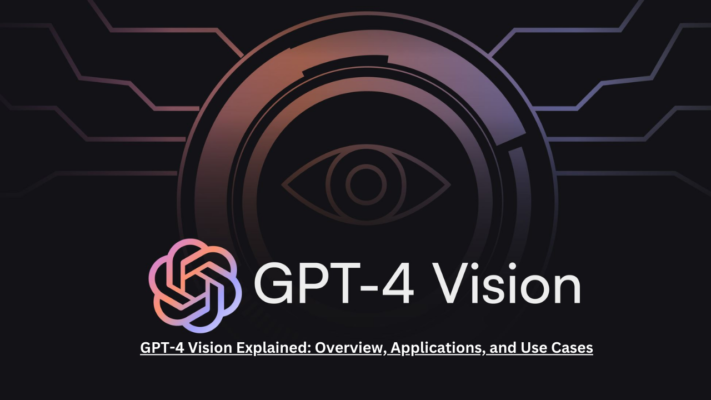
The field of artificial intelligence (AI) has witnessed remarkable advancements, with the introduction of large language models (LLMs) like GPT-3 and ChatGPT. These models have demonstrated remarkable capabilities in understanding and generating human-like text, revolutionizing various industries. Now, Anthropic has taken a significant step forward by introducing GPT-4 Vision (GPT-4V), a multimodal AI model that combines natural language processing with computer vision capabilities. In this comprehensive blog, we’ll explore the concept of GPT-4 Vision, its input modes, working principles, applications, and use cases across various industries.
What is GPT-4 Vision?
GPT-4 Vision, also known as GPT-4V, is a cutting-edge AI model developed by Anthropic that combines the power of natural language processing (NLP) with computer vision capabilities. It is an extension of the highly successful GPT-4 language model, which has garnered significant attention for its impressive performance in language-related tasks.
Unlike its predecessor, GPT-4V is a multimodal model, meaning it can process and understand not only text but also visual data, such as images and videos. This multimodal capability opens up a wide range of applications and use cases, allowing the model to perceive and comprehend the world in a more human-like manner.
GPT-4V’s input modes
One of the key advantages of GPT-4V is its ability to accept various input modes, including:
1. Text input: GPT-4V can process and understand natural language input, similar to its predecessor, GPT-4.
2. Image input: The model can analyze and comprehend visual information from images, enabling tasks such as image captioning, object detection, and scene understanding.
3. Video input: GPT-4V can process video data, allowing for applications like video captioning, action recognition, and temporal understanding.
4. Multimodal input: Perhaps the most powerful aspect of GPT-4V is its ability to process and understand a combination of text, images, and videos simultaneously, enabling more complex and context-rich applications.
How does GPT-4 Vision work?
GPT-4 Vision is built upon a transformer-based architecture, similar to other large language models. However, it incorporates advanced computer vision techniques and multimodal fusion mechanisms to process and understand visual data alongside textual information.
The model’s architecture consists of several key components:
1. Visual Encoder: This component is responsible for processing and encoding visual data, such as images and videos, into a format that can be understood by the model’s transformer layers.
2. Language Encoder: Similar to previous language models, this component encodes textual input into a numerical representation that can be processed by the transformer layers.
3. Multimodal Fusion: GPT-4V employs various fusion techniques to combine and integrate the encoded visual and textual information, enabling the model to understand and reason across multiple modalities.
4. Transformer Layers: These layers, inspired by the transformer architecture used in natural language processing, process the fused multimodal representations and generate the final output, which can be text, visual data, or a combination of both.
GPT-4V’s working modes and prompting techniques
GPT-4 Vision can operate in different modes and respond to various prompting techniques, depending on the task and the desired output. Some of the working modes and prompting techniques include:
1. Text Generation: In this mode, GPT-4V can generate human-like text based on visual and textual inputs, enabling applications like image/video captioning, visual question answering, and visual storytelling.
2. Visual Analysis: The model can analyze and understand visual data, allowing for tasks such as object detection, scene understanding, and image/video classification.
3. Multimodal Understanding: GPT-4V excels at comprehending and reasoning across multiple modalities, enabling complex applications like visual reasoning, visual-language navigation, and multimodal question answering.
4. Prompting Techniques: Users can interact with GPT-4V using various prompting techniques, such as natural language prompts, image and video prompts, or a combination of both, allowing for more intuitive and context-rich interactions.
The vision-language capability of GPT-4V
One of the key strengths of GPT-4V lies in its ability to understand and reason about the relationship between visual and textual data. This vision-language capability enables a wide range of applications, including:
1. Visual Question Answering (VQA): GPT-4V can analyze images or videos and provide accurate answers to questions that require understanding and reasoning about the visual content in the context of natural language.
2. Image/Video Captioning: The model can generate human-like descriptions or captions for images and videos, accurately describing the visual content, actions, and relationships within the scene.
3. Visual-Language Navigation: GPT-4V can understand and follow natural language instructions in the context of visual environments, enabling applications like virtual assistants or robotic navigation systems.
4. Visual Reasoning: The model can perform complex reasoning tasks that involve understanding and interpreting visual information in combination with textual data, enabling applications in fields like medical diagnosis, legal analysis, and scientific research.
Temporal and video understanding
While most computer vision models focus on processing static images, GPT-4V’s capabilities extend to understanding and reasoning about temporal data, such as videos. This temporal understanding enables a range of applications, including:
1. Action Recognition: GPT-4V can recognize and classify actions occurring in videos, enabling applications like surveillance, sports analytics, and human-computer interaction.
2. Video Summarization: The model can generate concise summaries of long videos, capturing the most important events and information, making it useful for content analysis and video indexing.
3. Temporal Reasoning: GPT-4V can understand and reason about the temporal relationships between events, actions, and objects in videos, enabling applications like video question answering and video storytelling.
4. Multimodal Video Understanding: The model can comprehend and reason about videos in the context of accompanying text or audio data, enabling applications like automatic video captioning or audio-visual content analysis.
Use cases of GPT-4V
The versatility and capabilities of GPT-4 Vision make it applicable to a wide range of use cases across various domains:
1. Visual Assistants: GPT-4V can power intelligent virtual assistants that can understand and respond to multimodal queries, combining text, images, and videos, enabling more natural and intuitive human-computer interactions.
2. Multimedia Content Analysis: The model can be employed for tasks like automatic image/video captioning, content moderation, and multimedia search, enabling more efficient content management and retrieval.
3. Healthcare and Medical Imaging: GPT-4V’s ability to understand and reason about medical images and patient data can be leveraged for applications like medical diagnosis, treatment planning, and clinical research.
4. Robotics and Autonomous Systems: The model’s multimodal understanding capabilities can be integrated into robotic systems, enabling tasks like visual navigation, object manipulation, and human-robot interaction.
5. Education and Learning: GPT-4V can be used to create interactive and engaging educational materials, combining text, images, and videos to enhance the learning experience and facilitate visual comprehension.
6. Creative Industries: The model’s ability to generate and manipulate visual content can be utilized in fields like advertising, graphic design, and media production, enabling more creative and visually compelling outputs.
Applications of GPT-4V across industries
The potential applications of GPT-4 Vision span across various industries, including:
1. E-commerce and Retail: GPT-4V can enhance product search and recommendation systems by understanding and reasoning about product images, descriptions, and customer preferences, leading to improved customer experiences and increased sales.
2. Manufacturing and Quality Control: The model can be integrated into quality control processes, enabling automatic defect detection, visual inspection, and real-time monitoring of manufacturing operations.
3. Media and Entertainment: GPT-4V can be employed for tasks like automatic video captioning, visual content generation, and interactive storytelling, enabling more engaging and immersive media experiences.
4. Security and Surveillance: The model’s ability to understand and analyze visual data can be leveraged for applications like video surveillance, facial recognition, and threat detection, enhancing security and public safety measures.
5. Transportation and Logistics: GPT-4V can be used for tasks like autonomous vehicle navigation, traffic monitoring, and route optimization, improving transportation efficiency and safety.
6. Scientific Research: The model’s multimodal understanding capabilities can be applied to scientific domains, enabling tasks like visual data analysis, hypothesis generation, and knowledge discovery, accelerating scientific progress.
Benefits of GPT-4V
Incorporating GPT-4 Vision into various applications and workflows can provide numerous benefits:
1. Improved Efficiency: GPT-4V’s ability to process and understand multimodal data can streamline tasks that previously required manual intervention, leading to increased efficiency and productivity.
2. Enhanced User Experience: By enabling more natural and intuitive interactions that combine text, images, and videos, GPT-4V can significantly enhance.
3. Insights from Multimodal Data: GPT-4V’s capability to understand and reason across multiple modalities allows for deeper insights and more comprehensive analysis, enabling better decision-making and problem-solving.
4. Automation of Complex Tasks: The model’s advanced multimodal understanding and reasoning capabilities make it possible to automate tasks that were previously too complex or required human expertise, leading to cost savings and increased productivity.
5. Personalized and Contextual Interactions: By understanding the context and nuances of multimodal data, GPT-4V can provide more personalized and relevant responses, enhancing user satisfaction and engagement.
6. Accelerated Innovation: The ability to process and understand multimodal data can foster innovation by enabling the development of new applications and solutions that were previously impossible or impractical.
How can Upcore Technologies help in building LLM-powered solutions?
As the applications of large language models (LLMs) like GPT-4 Vision continue to expand, organizations across various industries are seeking ways to leverage these cutting-edge technologies to drive innovation and gain a competitive edge. Upcore Technologies, a leading technology consulting firm, is well-positioned to assist businesses in harnessing the power of LLMs and building LLM-powered solutions.
With a team of experts specializing in Predictive Analytics services, AI Consulting, Machine Learning Services, RPA solutions, and Computer Vision services, Upcore Technologies stays ahead of the curve by closely following the latest Machine Learning trends and AI Trends. Their deep understanding of emerging technologies, combined with their domain expertise, allows them to develop tailored solutions that address the unique challenges and requirements of each client.
Here’s how Upcore Technologies can help businesses leverage GPT-4 Vision and other LLM-powered solutions:
1. Strategy and Roadmap Development: Upcore Technologies can assist organizations in developing a comprehensive strategy and roadmap for adopting LLM technologies like GPT-4 Vision. This includes identifying potential use cases, assessing the organization’s readiness, and creating a phased implementation plan.
2. Solution Design and Development: With their expertise in AI and machine learning, Upcore Technologies can design and develop LLM-powered solutions tailored to specific business needs. This may involve integrating GPT-4 Vision with existing systems, building custom applications, or developing end-to-end solutions from scratch.
3. Data Preparation and Model Training: Ensuring the quality and relevance of training data is crucial for the success of LLM-powered solutions. Upcore Technologies can assist with data preparation, cleaning, and annotation, as well as provide guidance on model training and fine-tuning strategies.
4. Integration and Deployment: Once the LLM-powered solution is developed, Upcore Technologies can help with seamless integration into the organization’s existing workflows and systems. They can also provide support for deployment, testing, and ongoing maintenance.
5. Consulting and Advisory Services: Upcore Technologies offers expert consulting and advisory services to help organizations navigate the complexities of LLM technologies, address potential challenges, and ensure compliance with relevant regulations and ethical considerations.
6. Continuous Improvement and Support: As LLM technologies continue to evolve rapidly, Upcore Technologies can provide ongoing support, monitoring, and continuous improvement services to ensure that the organization’s LLM-powered solutions remain up-to-date and effective.
By partnering with Upcore Technologies, businesses can leverage the transformative potential of GPT-4 Vision and other LLM-powered solutions, driving innovation, improving operational efficiency, and gaining a competitive edge in their respective industries.


